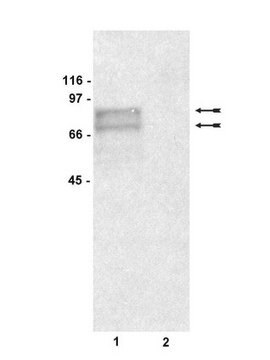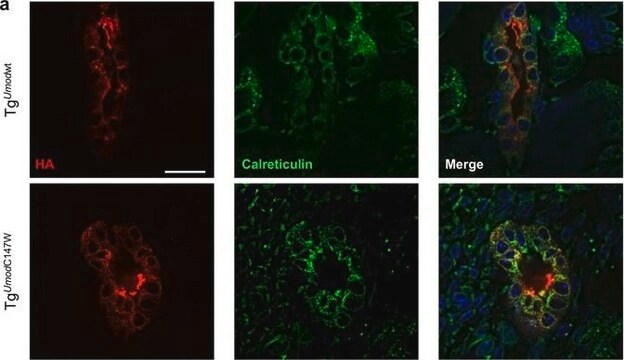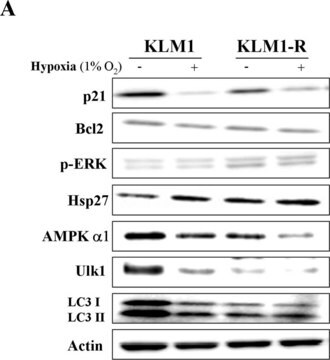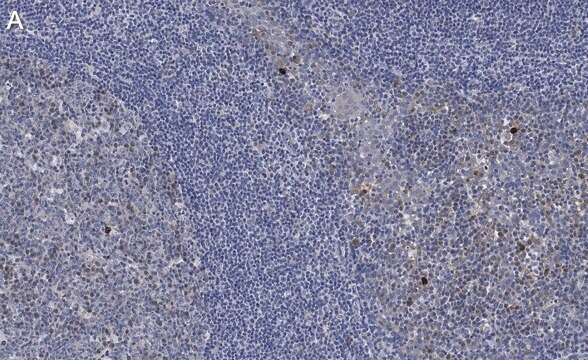MABC592
Anti-TRP1/TYRP1 Antibody, clone TA99, Azide Free
clone TA99, 1 mg/mL, from mouse
Sinónimos:
5,6-dihydroxyindole-2-carboxylic acid oxidase, DHICA oxidase, Catalase B, Glycoprotein 75, Melanoma antigen gp75, Tyrosinase-related protein 1, TRP, TRP-1, TRP1
About This Item
Productos recomendados
origen biológico
mouse
Nivel de calidad
forma del anticuerpo
purified immunoglobulin
tipo de anticuerpo
primary antibodies
clon
TA99, monoclonal
reactividad de especies
human, mouse
concentración
1 mg/mL
técnicas
blocking: suitable (interfering antibodies)
flow cytometry: suitable
immunohistochemistry: suitable
immunoprecipitation (IP): suitable
western blot: suitable
isotipo
IgG2aκ
Nº de acceso NCBI
Nº de acceso UniProt
Condiciones de envío
wet ice
modificación del objetivo postraduccional
unmodified
Información sobre el gen
human ... TYRP1(7306)
Descripción general
Inmunógeno
Aplicación
Blocking of Interferring Antibodies Analysis: A representative lot from an independent laboratory suppressed the growth of subcutaneous B16 tumors (Patel, D., et al. (2008). Anticancer Res. 28(5A):2679-2686.).
Activity Assay Analysis: A representative lot from an independent laboratory improves anti-tumor efficacy by augmenting systemic CD8+T cell responses to tumor cells (Saenger, Y. M., et al. (2008). Cancer Res. 68(23):9884-9891.).
Immunoprecipiptation Analysis: A representative lot from an independent laboratory immunoprecipiated TRP1/TYRP1 from B16 cell lysate (Srinivasan, R., et al. (2002). Cancer Immun. 19(2):8.).
Apoptosis & Cancer
Apoptosis - Additional
Calidad
Western Blotting Analysis: 1 µg/mL of this antibody detected TRP1/TYRP1 in 10 µg of mouse skin tissue lysate.
Descripción de destino
Forma física
Almacenamiento y estabilidad
Handling Recommendations: Upon receipt and prior to removing the cap, centrifuge the vial and gently mix the solution. Aliquot into microcentrifuge tubes and store at -20°C. Avoid repeated freeze/thaw cycles, which may damage IgG and affect product performance.
Cláusula de descargo de responsabilidad
¿No encuentra el producto adecuado?
Pruebe nuestro Herramienta de selección de productos.
Código de clase de almacenamiento
12 - Non Combustible Liquids
Clase de riesgo para el agua (WGK)
WGK 2
Punto de inflamabilidad (°F)
Not applicable
Punto de inflamabilidad (°C)
Not applicable
Certificados de análisis (COA)
Busque Certificados de análisis (COA) introduciendo el número de lote del producto. Los números de lote se encuentran en la etiqueta del producto después de las palabras «Lot» o «Batch»
¿Ya tiene este producto?
Encuentre la documentación para los productos que ha comprado recientemente en la Biblioteca de documentos.
Nuestro equipo de científicos tiene experiencia en todas las áreas de investigación: Ciencias de la vida, Ciencia de los materiales, Síntesis química, Cromatografía, Analítica y muchas otras.
Póngase en contacto con el Servicio técnico








